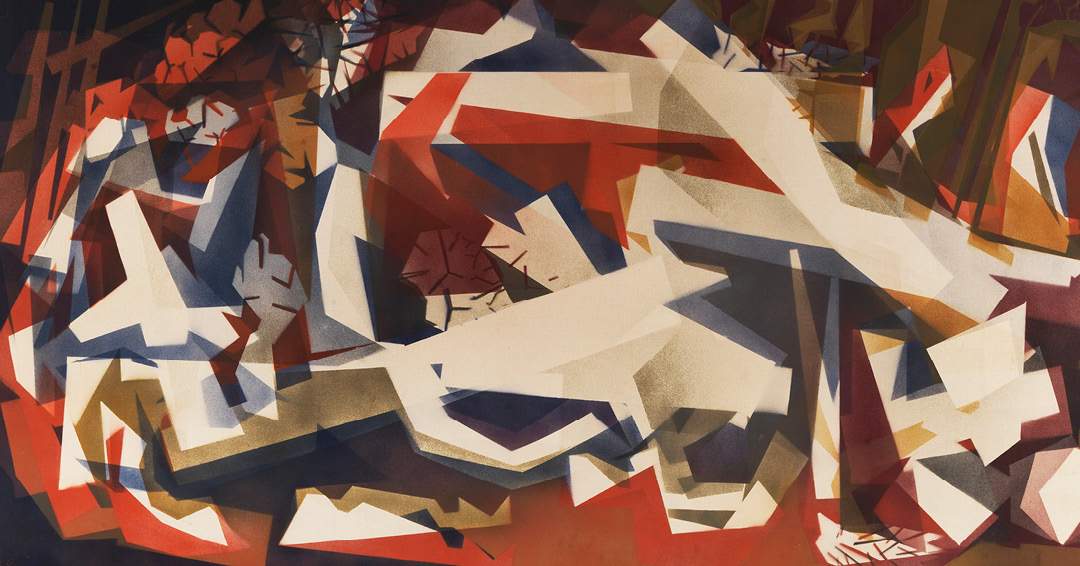A journey into the surprising world of Corrado Cagli (Ancona, 1910 - Rome, 1976), a great painter and master of the 20th century: is the one proposed by the exhibition Cagli 1947-1959 at the Galleria Antichità Alberto Di Castro in Rome, curated by Alberto Di Castro, Denise Di Castro, Gian Enzo Sperone and Yuri Tagliacozzo, from March 30 to May 5, 2023.
Cagli’s activity has always been oriented toward a multidisciplinary horizon, from painting to sculpture and ceramics, from theater to dance. His experiments have been of great inspiration to artists such as Afro, Guttuso, Burri and Schifano.
The works on display - some 30 of the most iconic of his output - were made in the postwar period. As a result of racial laws, Cagli was forced to leave Rome, staying first in Paris and then in New York, where he met and frequented the most important cultural avant-gardes, collaborating with Stravinsky and Balanchine. He returned to Europe with the U.S. Army, establishing himself at the center of the Italian art scene. The paintings in the exhibition date from the most prolific and highest quality phase within his oeuvre. During his stay-refuge in Marseille, J. Herold and Max Ernst, among others, made an artist’s tarot deck. André Breton continued these studies during his American exile, involving Cagli and artists who frequented the Julien Levy Gallery in New York. The exhibition presents some of his most recognizable esoteric tarot-related images, such as Wheel of Fortune and the Bagatto as Harlequin. Also featured is a selection of works from 1949 that experiment with the fourth dimension, such as The Anguish and Diogenes, characterized by a strongly expressive gestural style.
The artist, a revolutionary innovator, went so far as to abandon the paintbrush, experimenting with new techniques that would give rise to “direct imprints” and “indirect imprints”-of which one of the most historicized masterpieces, Ça Irà-is on display in the exhibition. "Ça Irà somehow remains in Cagli’s lyricism what Guernica is in Picasso’s realism"(E. Crispolti, G. Marchiori, 1964). Also exhibited will be works that enhance his search for the primordial(Symbols, 1956, and Flotta Arunta, 1957), which stimulated young Roman artists of Capogrossi’s caliber. Finally, an impressive series of “mute papers” made between 1958 and 1959, where the artist converges art, science, craftsmanship and theory to create extraordinary optical effects, will be offered.
The exhibition constitutes the second collaboration between Alberto Di Castro and Gian Enzo Sperone, longtime friends as well as professional colleagues: Sperone, an avant-garde gallery owner and world-renowned collector; Di Castro, a historic reference of international antiques.
Joining them for the first time are Denise Di Castro, representative of the fifth generation of the family, who, after earning her master’s degree at the Courtauld Institute of Art, curates important cultural projects and new exhibitions at the gallery; and Yuri Tagliacozzo, a young collector who gathered the paintings for the exhibition.
The catalog, published by Silvana Editoriale, contains introductions by Denise and Alberto Di Castro, Gian Enzo Sperone, and Yuri Tagliacozzo, a critical essay by Ester Coen, and historical contextualization by Veronica Prestini.
The exhibition is organized in collaboration with theCorrado Cagli Archive.
Corrado Cagli was born in Ancona on February 23, 1910 to a family belonging to the Jewish community. In the 1930s in Rome he proposed the poetics of Primordialism and Archaism in the School that saw him as a protagonist together with Capogrossi and Cavalli. In 1936 he made the monumental Battaglia di San Martino e Solferino (Battle of San Martino and Solferino) for the VI Triennale in Milan, now housed in the Uffizi. In 1937 the French Republic awarded the artist a gold medal for creating a cycle of paintings (168 sq. m.) in the vestibule of the Italian pavilion at theExposition Internationale in Paris. The following year, with the enactment of the racial laws, he was forced to leave Italy, taking refuge first in Paris and then in New York, where he enlisted as a volunteer in the U.S. Army and participated in numerous campaigns in Europe, such as the Normandy landings and the liberation of the Buchenwald concentration camp in 1945. From 1948 onward he settled permanently in Rome, his artistic homeland, and here he experimented with techniques and pictorial languages for his formal and abstract works, which also led him to receive numerous awards: the Guggenheim Fellowship for painting (1946), the Marzotto Prize (1954), and the President of the Republic Award for painting from theAccademia Nazionale di San Luca (1973). He died in Rome on March 28, 1976.
For all information, you can visit the official website of Antichità Alberto Di Castro.
Image: Corrado Cagli, Ca Irà (1951)
 |
| Rome, at the Alberto di Castro Antiquities Gallery an exhibition dedicated to Corrado Cagli |
Warning: the translation into English of the original Italian article was created using automatic tools. We undertake to review all articles, but we do not guarantee the total absence of inaccuracies in the translation due to the program. You can find the original by clicking on the ITA button. If you find any mistake,please contact us.